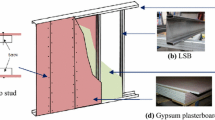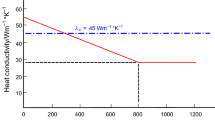Abstract
A comprehensive research project on the fire performance of a new light mineral wool has been carried out at ETH Zurich in collaboration with the Swiss Federal Laboratories for Materials Science and Technology (EMPA). A large number of small-scale fire tests permitted the analysis of different parameters on the fire performance of the new mineral wool. The results of the fire tests allowed the verification and calibration of thermal properties used for thermal finite element (FE) analysis. Based on an extensive FE parametric study, the coefficients for the new mineral wool to be used in the design model for the verification of the separating function of light timber frame wall and floor assemblies were calculated. The paper first describes the main results of the experimental and numerical analyses. Then, the calculation of the coefficients for the new mineral wool to be used in the design model are presented.
















Similar content being viewed by others
References
Papadopoulos A.M. State of the art in thermal insulation materials and aims for future developments, Energy and Buildings 2005, 37: 77–86.
Frangi A., Knobloch M., Fontana M. Fire design of timber slabs made of hollow core elements, Engineering Structures 2009, 31: 150–157.
Schleifer V, Frangi A, Fontana M (2007) Experimentelle Untersuchungen zum Brandverhalten von Plattenelementen, Institute of Structural Engineering IBK, ETH Zurich, IBK-report No. 302
Coray S., Hug R., Brandverhalten von Dämmplatten aus Glaswolle, Projektarbeit (Master), Institute of Structural Engineering IBK, ETH Zurich, 2008.
König J, Oksanen T, Towler K (2000) A review of component additive methods used for the determination of fire resistance of separating light timber frame construction, Paper CIB-W18/33-16-2, CIB Working Commission W18—Timber Structures, Delft, Netherlands
EN 1995-1-2 (2004) Eurocode 5—design of timber structures, part 1–2: general—structural fire design, European Standard, CEN, Brussels
König J. Structural fire design according to Eurocode 5 - Design rules and their background. Fire and Materials 2005; 29:147–163.
Schleifer V (2009) Zum Verhalten von raumabschliessenden mehrschichtigen Holzbauteilen im Brandfall, PhD Thesis ETH No. 18156, ETH Zurich
Frangi A., Schleifer V., Fontana M., Design model for the verification of the separating function of light timber frame assemblies, Engineering Structures 2010, 32: 1184–1195.
EN 13501-2 (2007) Fire classification of construction products and building elements—part 2: classification using data from fire resistance tests, excluding ventilation services, European Standard, European Standard, CEN, Brussels
EN 520 (2004) Gypsum plasterboards, definitions, requirements and test methods, European Standard, CEN, Brussels
EN 15283-2 (2008) Gypsum boards with fibrous reinforcement—definitions, requirements and test methods—part 2: gypsum fibre boards; European Standard, CEN, Brussels
ISO 834-1 (1999) Fire-resistance tests—elements of building construction—part 1: general requirements
EN 312 (2003) Particleboards—specifications, European Standard, CEN, Brussels
ANSYS Inc. ANSYS Workbench Version 11.0, Canonsburg, USA
EN 1991-1-2 (2002) Eurocode 1: actions on structures—part 1–2: general actions—actions on structures exposed to fire, European Standard, CEN, Brussels
Thomas G., Thermal properties of gypsum plasterboards at high temperatures, Fire and Materials 2002, 26: 37-45.
Källsner B, König J (2000) Thermal and mechanical properties of timber and some other materials used in light timber frame construction, paper CIB-W18/33-16-3, CIB Working Commission W18—Timber Structures, Delft, Netherlands
Just A (2009) Full scale wall tests of timber frame assemblies, Test report, Tallinn, University of Technology
Versuchsbericht Nr. 210003433-1 (April 2004) Materialprüfanstalt Nordrhein-Westfalen
Frangi A., Erchinger C., Fontana M., Charring model for timber frame floor assemblies with void cavities, Fire Safety Journal 43 (2008) 551–564.
Studhalter J (2007) Beurteilungsgrundlagen für die werkstoffoptimierten Bauteile Isover, Lignum-Dokumentation Brandschutz: Bauteile in Holz—Decken, Wände und Bekleidungen mit Feuerwiderstand
Just A, Schmid J, König J (2010) Failure times of gypsum plasterboards, Interflam 2010. In: Proceedings of the 12th international conference, 5 July 2010, Nottingham, UK
Author information
Authors and Affiliations
Corresponding author
Rights and permissions
About this article
Cite this article
Frangi, A., Schleifer, V. & Hugi, E. A New Fire Resistant Light Mineral Wool. Fire Technol 48, 733–752 (2012). https://doi.org/10.1007/s10694-010-0209-2
Received:
Accepted:
Published:
Issue Date:
DOI: https://doi.org/10.1007/s10694-010-0209-2




